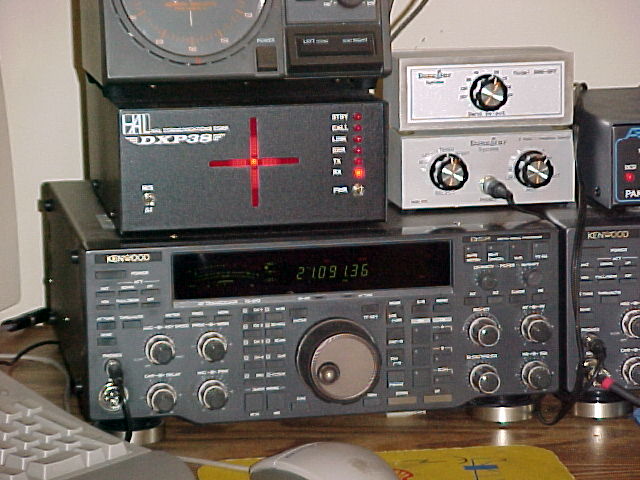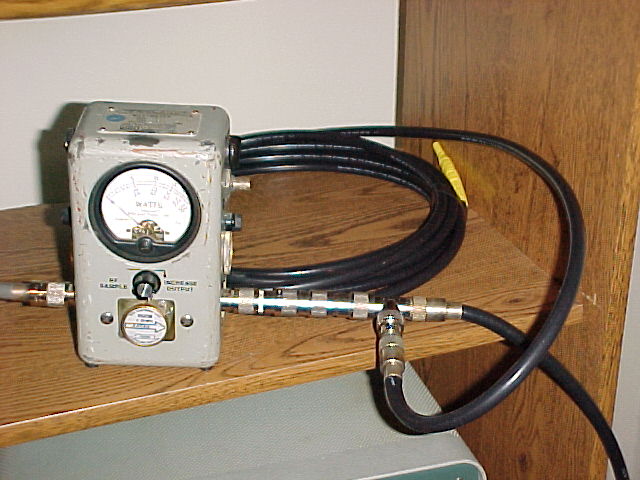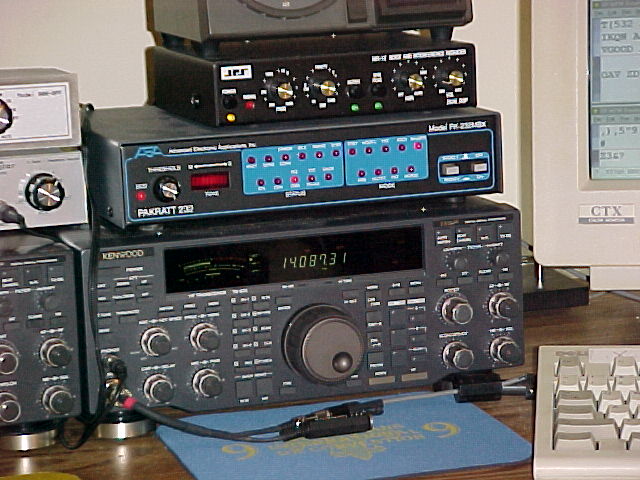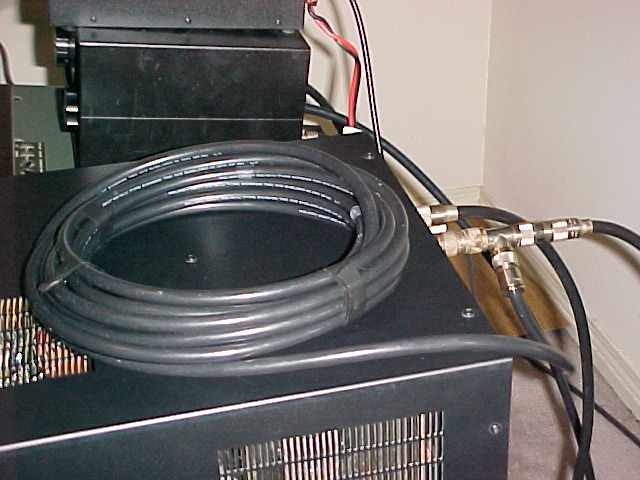This year’s 2001 ARRL RTTY Roundup will go down as the best ever. Conditions were excellent and activity was at an all time high. This is my favorite contest of the year. I have been fortunate to have won the Low Power category of this contest eight times including the last six years in a row (1995-2000).
This year I had several goals in mind. The ultimate goal for me was to achieve the 1,440 QSO total mark. This total represents making one QSO per minute on average for the entire 24 hour single operator permitted period. My secondary goal was to surpass my 1999 World Record of 152,625 points. I had no idea I was about to shatter both these goals.
In the last two Roundups, I had incorporated 3 radios. However, after doing some RTTY contesting in 2000 with 3 radios, I came to the conclusion that two radios are actually better than three. Concentrating on three radios is too difficult for me. I found that I could operate much more efficiently using only two radios. For this year’s contest I had a 3rd radio set up and ready to operate. I made only 2 QSO’s with it on 10 meters. I designated it as my backup in case of failure with the two main radios.
During the year 2000 a lightning strike at my QTH would impact this year’s Roundup. Two of my three radios were damaged (a Kenwood TS-870 and one of my two Icom IC-751A’s). While my TS-870 was in for repair, I purchased another TS-870. My original TS-870 was repaired and now I had two TS-870’s. The Kenwood TS-870 is the best transceiver I have ever used on RTTY. Having two of them as my main radios in the 2001 Roundup would give me a big boost over previous years when I used only one TS-870 and the two Icoms. The Icom IC-751A is still an excellent RTTY radio, especially when equipped with the 250 hz filter, but it is no match to the Kenwood with it’s IF DSP filtering.
Another advantage the 2nd Kenwood gave me was computer control on both radios. I would now be able to use WriteLog’s bandmap feature with both radios.
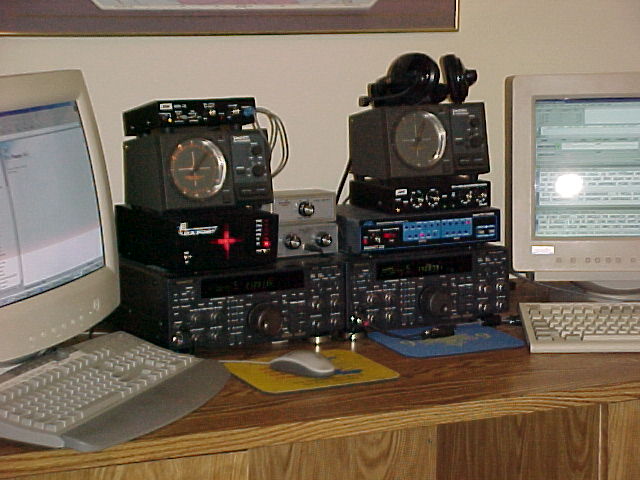 The station setup I used for the 2001 ARRL RTTY Roundup.
The station setup I used for the 2001 ARRL RTTY Roundup.
STATION “A”
Station “A” consisted of a Kenwood TS-870 transceiver, a Hewlett-Packard Pavilion 200 Mhz Pentium computer running WriteLog version 10.23B (beta) under Windows 98SE, a JPS NIR-10 audio filter and a HAL DXP-38 TNC. This station was designated for 15 and 40 meters and was equipped with Dunestar bandpass filters and a 23′ shorted stub for 15 and 40 meters connected to the output of a Bird wattmeter.
The DXP-38 was used for both transmit and receive. I opened up a 2nd RTTY window in WriteLog and used the left channel of the stereo sound card in the HP computer for dual receive by splitting the audio output of the NIR-10 filter feeding one leg to the DXP-38 and the other to the left channel input of the soundcard. During rough copy conditions, if the DXP-38 misses any print, the sound card normally receives it OK and vice versa.
The computer on station “A” was networked to the computer on station “B” through a 3COM Ethernet hub.
STATION “B”
Station “B” consisted of a Kenwood TS-870 transceiver, a Dell 166 Mhz Pentium computer running WriteLog version 10.23B (beta) under Windows 95, a JPS NIR-12 Dual DSP audio filter and a PK232MBX TNC. This station is designated for 10, 20 and 80 meters. This station is equipped with an open 23′ stub for 10 and 20 meters plus a Dunestar 600 switchable band filter which allows this station to be used on any band 10-80M.
The PK232 was used for both transmit and receive. I opened up a 2nd RTTY window in WriteLog and used the left channel of the stereo sound card like in station “A” for dual receive. This 2nd RTTY window also was capable of being switched to operate PSK31. However, I made no PSK31 contacts. The activity on RTTY was too high.
STATION “C”
Station “C” consisted of an Icom IC-751A with a 250 hz filter in the IF. I used the right channel of the sound card in the station “B” computer to decode the RTTY. I used an extra COM port on the same computer to key PTT and FSK. This station was dedicated to 10 meters only and used a Dunestar 10M filter. It was mainly a “spare” station in case of failure with either of the other two stations. I made only two contacts using this radio.
Strategy and How It Worked
Strategy #1 – How much time spent on each band.
In the days before the contest I tried to lay out a strategy for the contest. I looked at my logs for the past two years and tried to determine what I could do to improve my score. In 2000, I thought I had made more an effort than in 1999, but my score was somewhat lower. I noticed some major differences between the two logs. In 1999, I made more contacts on 10 & 15 meters. In 2000, I made more contacts on 80 meters. It seemed that I spent more time on 40 and 80 in 2000 than I did in 1999. Multipliers, especially DX, are more readily available on 10 and 15 meters as shown by the logs. My first strategy going into the contest was to spend significantly more time on 10 and 15 meters this year and spend less time on 80 meters.
Strategy #2 – When to change bands.
The next strategy I thought about was when to change bands. I always start the contest on 10 and 15 meters. The big decisions are when to move radio “A” from 15 to 40 meters and when to move radio “B” from 10 to 20 meters. It seemed that in 2000 I left 15 meters and moved to 40 on the “A” radio an hour earlier than in 1999. Since I wanted to make at least 250 contacts on 40 meters, I had to make sure I went there at the right time in 2001 and not leave myself short on 15 or 40. The move from 10 to 20 meters on radio “B” is always dependent on how the 10 meter band is on that particular day. My thoughts are that I will hit 10 and 15 meters very hard on Sunday morning, so when 10 starts slowing down on the first day, it’s time to move to 20 meters quickly on radio “B”.
At 2015Z, I determined it was time to move from 10 to 20 meters on radio “B”. Ten slowed fast and my rate started to fall so I didn’t hesitate to move to 20. The next move for radio “B” is from 20 to 80 meters. My strategy was to stay on 20 meters longer and I wondered why I had gone to 80 so soon in 2000.
Then I remembered why I had gone to 80 earlier in 2000. It was because when I was on 40 meters and 20 meters at the same time, I had interference on 20 meters when I transmitted on 40 despite using band filters. I also remembered I didn’t have this problem in 1999 so on Friday, the day before the contest, I constructed two stubs as described on the previous page. I tested with one radio on 40 and the other on 20 meters and found that these stubs made a significant reduction to the interference. Without the stubs, I had S5 noise on 20 when I transmitted on 40. With the stubs, the noise was reduced to S2 across the RTTY sub-band on 20 meters. The reason I had more contacts on 80 meters in 2000 was because I had to go there from 20 meters because the RFI was too bad on 20 when I was transmitting on 40 meters. These hastily constructed stubs made a big contribution to my 2001 effort.
With the newly made stubs, my strategy was to spend more time operating the combination of 40 and 20 meters before I went to 80 meters on radio “B”. So I decided on going to 40 from 15 meters at around 2330Z. As it turns out 15 was still going strong at 2330Z, I ended up going to 40 at 2345Z. I had to make that decision and despite 15 still being good, I forced myself to go to 40. I probably should have gone at 2330Z as planned because my rate jumped dramatically when I moved to 40. With the stubs, I was able to operate 40 and 20 meters at the same time for 2 hours and 15 minutes and made 174 contacts.
The next decision was when to move from 20 to 80 meters on radio “B”. I didn’t plan ahead for this. I only knew I wanted less contacts on 80. The stubs allowed me to continue longer on 20, but I wanted at least 150 contacts on 80 meters so I went there at 0200Z. Since radio “B” is equipped with a switchable Dunestar 600 filter, I am able to go back and forth from 80 to 20 quickly and that’s what I did. At 0230Z, I planted myself on 80 permanently and operated 40 and 80 until 0700Z (1 a.m. local time) when I rested. I ended up with 145 contacts on 80 and 250 contacts on 40. My total at that time was 941 contacts. I was very pleased.
Strategy #3 – Rest periods.
The 3rd and final strategy in this contest is when to take rest periods. The rules state you must take 6 hours of rest for single operators in two periods. The ARRL has allowed single operators to take the entire 6 hours at once (2 – 3 hour rest periods back-to-back). In 1999, I took all 6 hours at once. In 2000, I took 5.75 hours once, then 15 minutes during the day Sunday. I decided in 2001 I would take all 6 hours at one time.
The biggest question is when to take these 6 hours. To answer that I listened to the bands the previous two mornings to find out when 15 and 10 meters opened. I determined that 15 meters opened up at 1315Z the previous 2 days. Since there wasn’t much activity, I had to rely on my recent contest experiences in this sunspot cycle to guess that 10 meters opens at approximately the same time or perhaps 15-30 minutes later.
Since the bands seem to open “earlier” when a contest is going on, I decided I would start the 2nd day at 1300Z on 15 and 20 meters. With the 3rd radio on 10, I anticipated listening to this radio until I started hearing signals, then switch from 20 to 10 meters on radio “B”.
When to start on Sunday is a critical decision. Probably the most critical of all the strategies. The reason being that this is a rate contest. I have to make sure that 15 meters is open enough to get a good rate going, whether it be supported with contacts on 20 or 10 meters. 15 meters is only going to be open to Europe at that time for me. Running Low Power, I know that I hear Europe on 15 meters a few minutes earlier than they hear me.
Because I heard strong signals from Europe at 1315Z on 15 meters the previous two days, I decided beforehand to restart on Sunday at 1301Z. So at 0700 I went QRT for rest.
Sunday – A Day to Remember
Before going to bed Saturday night, I set radio “A” to 15 meters and radio “B” to 20 meters – both on the high side above 21.100 and 14.100 kHz respectively. I had set my alarm for 1200Z, but stayed in bed and got as much rest as possible. I climbed out of the sack at about 1245Z. The first thing I did when I got into the shack was to get on-line and check the WWV numbers. I don’t recall exactly what they were, but they looked good. I knew 15 and 10 would open early. From seeing those numbers I knew that 10 would be open and that I shouldn’t spend much time on 20 meters on radio “B”.
At 1301Z I put on the headphones. I immediately heard a signal on radio “B” on the frequency where I had left the radio on 20 meters. It was A52YL on 14104 kHz. She was calling CQ. My heart jumped out of my chest. I called her immediately and she came right back to me. I could not believe it! How lucky can I get? Was this an omen of good things to come?
After logging A52YL, I made a quick decision to go straight to 10 meters without even tuning the rest of 20M. When I flipped to 10 meters, I just happened to land on UW8I calling CQ. One call and he was in the log. In the meantime, I came across LZ2PI on 15 meters and got him on one call. Things were starting very nicely!
My stategy before the contest was to keep radio “A” on 15 meters the entire rest of the contest. And with the small exception of checking 40 meters at about 2300Z for a few minutes, that’s what I did. On radio “B”, the strategy was to work 10 meters until the rate fell. For the next six hours I pounded 10 and 15 meters with all my might yielding 396 contacts and a great deal of multipliers.
A Big Decision
Things were going well combining 10 and 15 meters, but there was something heavy weighing on my mind. I had to make a decision when to move from 10 to 20 meters on radio “B”. The rate was slowing down a bit on 10. Europe was just about gone at 1900Z but stateside was still abundant. And I had worked all states except Georgia. I did not work all states in 1999 or 2000. But if I wanted to take full advantage of multipliers, I knew I needed to work Georgia. I realized that 10 meters was not going to yield any new multipliers in the middle of the day so at 1900Z I decided to change from 10 to 20 meters on radio “B”. 20 meters is normally not very good here in Louisiana at that time of day, but I felt I needed to make this change. This would ultimately be the best move I would make during the contest.
When I went to 20 meters at 1900Z, I found the band alive with plenty of signals. I found DJ7AA for my first contact in the Search & Pounce mode. This was a good sign. I normally don’t hear or work Europe this early on 20 meters. I worked a few more stations S&P until I settled on 14091 kHz and ran that frequency for a good hour. I maintained a good rate of 62 per hour and it increased as time went along. At 1954Z, N9HZQ called me on 20M from Georgia. He was my 1398th contact and I had finally worked all states.
The Final Strategy
The strategy for the last five hours was to pound 15 and 20 meters. And that is what I did. As the QSO count went past 1500, I turned my sights to 1600. With 300 QSO’s on 10 meters, I worked hard toward objectives of 500 QSO’s on 15 meters and 400 QSO’s on 20 meters.
In the last hour, things really slowed down. But one by one I reached all of these “spur of the moment” goals and reached 1611 QSO’s when I it was all over.
Totals
80M – 145 QSO’s
40M – 262 QSO’s
20M – 402 QSO’s
15M – 502 QSO’s
10M – 300 QSO’s
If someone would have told me I would end up with 1611 contacts, all 48 continental states, 11 Canadian provinces and 70 DXCC countries, I wouldn’t have believed it. But it did happen and this contest will forever be etched in my memory as one of the greatest efforts I would ever have in my RTTY contesting career.
And the people I have to thank for this achievement are those digital Amateur Radio operators who took part in the 2001 ARRL RTTY Roundup. If it were not for these operators, this achievement would not have been possible. And I thank each and every one of them.
